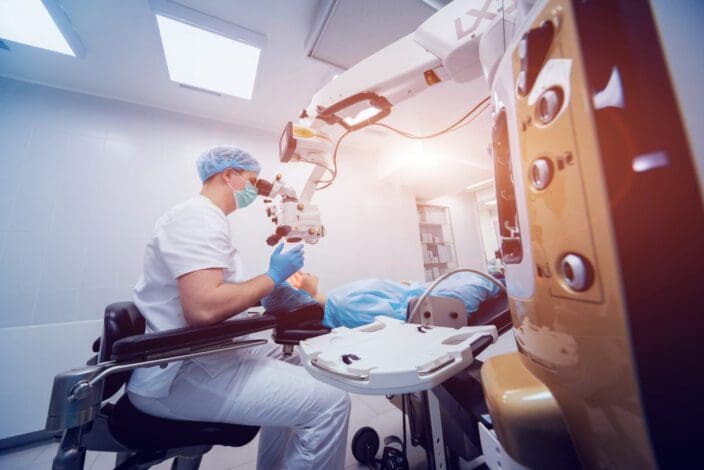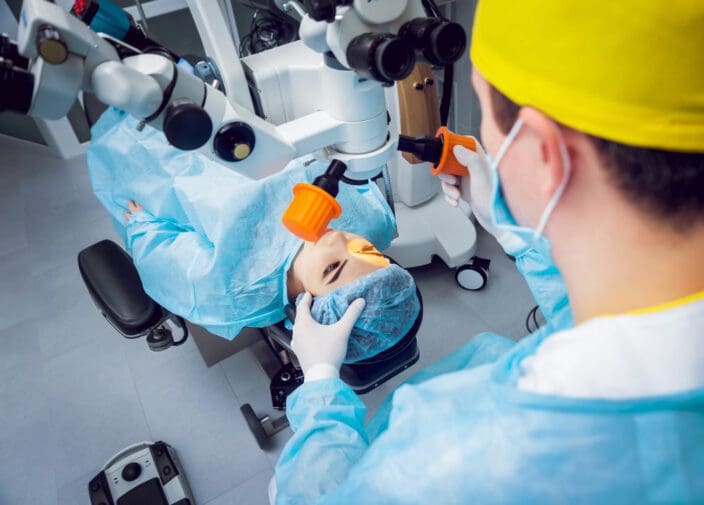PRK vs. LASIK for Patients with Dry Eyes
Home / Dry Eyes: Causes, Symptoms & Treatments /
Last Updated:
It is estimated that nearly half of all adults in the United States experience dry eye symptoms and signs. Dry eye is a common and uncomfortable condition that occurs when your eyes do not make enough tears or when your tears do not work the way they are supposed to work.
Table of Contents
Typically, dry eye is treated with medicine (like eye drops) or lifestyle changes (avoiding irritants), but it can also be managed surgically.
Dry eyes can also be a rare complication of refractive surgery. PRK is a form of refractive surgery that uses a laser to reshape the surface of your cornea. Another form of corrective refractive eye surgery, LASIK, also uses a laser, but it additionally cuts a flap in the cornea to ablate the tissue underneath.
PRK is traditionally considered the better option for corrective eye surgery if you suffer from dry eyes. LASIK is generally not recommended if you struggle with severe dry eyes, although advances in technology have opened up new possibilities. LASIK is often appropriate for mild to moderate cases, depending on the specifics of your condition.
Your eye doctor can help you decide what type of eye surgery or treatment is best for your dry eyes.
Surgery for Dry Eyes
Dry eye is a common condition that happens when your tears do not work well enough to keep your eyes properly moisturized, or your eyes do not produce enough tears. It can cause eye irritation and vision problems, and it can be very uncomfortable.
The National Eye Institute (NEI) publishes that treatments for dry eyes include:
You deserve clear vision. We can help.
With 135+ locations and over 2.5 million procedures performed, our board-certified eye surgeons deliver results you can trust. Your journey to better vision starts here.
- Eye drops. Either over-the-counter or prescription medications can help to ease symptoms of dry eye.
- Lifestyle changes. Avoid common eye irritants, wear eye protection, limit screen time, eat balanced meals, drink enough water, and get enough sleep.
- Tear duct plugs. A doctor can insert removable plugs into your tear ducts to keep tears in your eyes longer and prevent them from draining too fast. This results in more moisture staying in the eyes.
- Surgery. This is a less common treatment that is typically done when your eyelids are too loose to contain your tears. Surgery alters the eyelids so tears better stay in the eyes.
Surgery for dry eyes most commonly is for defective tear ducts or eyelids. It will help keep your tears from draining out of your eyes too fast.
Inserting plugs into your tear ducts is a procedure that can be reversed if needed. It entails placing punctal (silicone) plugs into the tear ducts. A more permanent procedure to close your tear ducts is thermal cautery, which involves heat.
If your eyelids are too droopy and are not working to keep your tears in your eyes for long enough, they can be tightened through surgery.
If you have dry eyes and are seeking refractive surgery to correct your vision, your doctor will need to take special precautions. Both LASIK and PRK can irritate the cornea and potentially lead to increased dry eye issues.
Newer technologies are more likely to prevent these complications. Your doctor will assess whether you are a good candidate for either type of refractive surgery.

Photorefractive Keratectomy (PRK)
PRK, photorefractive keratectomy, is a refractive eye surgery that uses a laser to reshape your cornea to correct errors. The surgery improves the way light focuses onto your retina, to sharpen your vision.
PRK can be used to treat astigmatism (irregularly shaped corneas), myopia (nearsightedness), and hyperopia (farsightedness).
During PRK, the epithelial layer of your cornea is removed, either with a special brush or via an alcohol solution. Then, the cornea itself is reshaped with a laser. PRK is an older technology that typically carries greater risk of complications.
It can take a few days for your vision to clear after PRK eye surgery and for the epithelial cells on your cornea to grow back. You will need to keep your eyes protected during the healing time.
Laser-Assisted In Situ Keratomileusis (LASIK)
PRK is the predecessor to LASIK. As technologies improve, recovery timelines generally shorten. The recovery timeline is shorter for LASIK than it is for PRK.
LASIK, laser-assisted in situ keratomileusis, uses a specialized laser to cut a flap in the outer layer of your cornea instead of removing it altogether. It is pushed to the side during surgery while the tissue underneath is reshaped by a laser and then replaced.
You must have a certain thickness of corneal tissue in order to be a candidate for LASIK. If you have thin corneas, LASIK is usually not an option, but PRK could be.
Just like PRK, LASIK refractive eye surgery can correct hyperopia, astigmatism, and myopia.

PRK for Dry Eyes
Like LASIK, PRK can eliminate your need to wear prescription eyeglasses or contacts. But if you have dry eye syndrome, you may think that all refractive surgery is off limits.
If you have dry eyes, PRK is still an option with proper precautions. Your doctor will need to evaluate your condition to determine the root cause of your dry eye and whether or not refractive surgery is likely to exacerbate it.
With PRK, your epithelial (outer) layer of your cornea is removed completely. It will grow back in a few days. The corneal tissue underneath is then reshaped to sharpen your vision and correct refractive errors.
You can experience some pain and blurry vision for a few days after PRK eye surgery. It can take up to a month for your vision to clear completely.
The American Academy of Ophthalmology (AAO) reports that if you have a thin cornea, dry eyes, or an extremely active lifestyle, PRK is usually a better option than LASIK.
You deserve clear vision. We can help.
With 135+ locations and over 2.5 million procedures performed, our board-certified eye surgeons deliver results you can trust. Your journey to better vision starts here.
LASIK for Dry Eyes
Severe dry eyes can be a reason some surgeons warn against LASIK eye surgery. Cutting the corneal flap can cause additional eye irritation, and this can worsen dry eye.
While some patients report dry eyes following the procedure, this symptom dissipates for the majority of people within a few weeks. If you suffer from severe dry eyes, LASIK is sometimes not recommended.
Your doctor will examine your eyes and determine whether or not you are a candidate for refractive eye surgery. If your dry eyes are the result of inferior tear ducts or loose eyelids, for example, these issues can be corrected.
Plugs can be placed in your tear ducts prior to LASIK surgery to keep your eyes properly moistened. Your surgeon will determine the cause of your dry eyes as well as how significant the issue is.
Commonly, dry eyes are due to the use of contact lenses. If this is the case for you, LASIK can actually alleviate your dry eyes. After LASIK, it’s likely that you will no longer need to wear contact lenses.
Your doctor can also work with you to rehabilitate your eyes prior to LASIK surgery, which can help to lower the risk for postoperative dry eyes.
LASIK surgery is a quick procedure done on an outpatient basis at a surgical center or ophthalmologist’s office. Recovery is relatively quick, and you should see better as soon as the next day. Total recovery time is up to six months, and you should see your eye doctor for regular checkups during this time.

Who Is Eligible?
For you to qualify for the laser corrective surgeries PRK and LASIK, you need to:
- Be at least 18 years of age. The U.S. Food and Drug Administration (FDA) only approves LASIK for individuals 18 or older.
- Have stable vision. Within the previous one to two years, you should not have needed to change your prescription.
- Be not pregnant and not breastfeeding at the time you’re to undergo surgery.
- Not be suffering from any condition that might delay the healing of your eyes, including chronic allergies and diabetes.
Which Procedure is Right for You?
Surgeons use the same tools for both LASIK and PRK surgeries, and both procedures have the same goal of restoring vision. However, the two differ slightly. Elements to weigh about each of the surgeries include how bad your current vision is, your expected recovery time and cost.
Current Vision
If you wear high-prescription lenses – glasses that are -8.00 magnification or more, PRK is more likely to yield better results for you than LASIK. The latter involves a flap-making process that requires an adequate amount of residual cornea to be effective. Individuals with poor eyesight usually have thin corneas that make PRK preferable over LASIK.
Expected Recovery Time
PRK involves the removal of the corneal surface. Therefore, it takes a longer time to heal than LASIK. If you can wait for at least a week to resume driving, you can go for PRK. Otherwise, LASIK would be a better option, as you can see clearly just hours after the surgery.
Cost
Generally, PRK is cheaper than LASIK as it doesn’t entail the additional step of creating a flap, making it simpler and quicker. However, your choice shouldn’t rely solely on the aspect of cost. Instead, opt for the procedure that is best for your vision.
Activity
Individuals taking part in activities that increase the risk of eye injury, such as competitive athletes, can consider PRK as the flap in LASIK can be damaged if the eye is not fully healed. Once you heal and the eye is anatomically normal, you can participate in any sports regardless of your surgery.
You deserve clear vision. We can help.
With 135+ locations and over 2.5 million procedures performed, our board-certified eye surgeons deliver results you can trust. Your journey to better vision starts here.
References
- Understanding the Prevalence, Demographics of Dry Eye Disease. (July 2019). Ophthalmology Times.
- Dry Eye. (July 2019). National Eye Institute (NEI).
- What Is Photorefractive Keratectomy (PRK)? (September 2017). American Academy of Ophthalmology (AAO).
- Dry Eye: PRK or LASIK? (September 2012). Ophthalmology Times.
- LASIK- Laser Eye Surgery. (December 2019). American Academy of Ophthalmology (AAO).
- Refractive Surgery and the Dry Eye Patient. (March 2013). Review of Ophthalmology.
- LASIK vs. PRK: Which Vision Correction Surgery Is Right for You? (December 2017). Michigan Health.
This content is for informational purposes only. It may have been reviewed by a licensed physician, but is not intended to serve as a substitute for professional medical advice. Always consult your healthcare provider with any health concerns. For more, read our Privacy Policy and Editorial Policy.